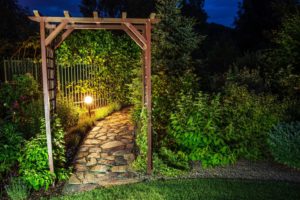 The sun may have gone down, but your home's curb appeal shouldn’t go down with it. Outdoor lighting, when done well, adds to and enhances your home’s allure. You can highlight the areas you like so the natural beauty shines through. It is the difference between a typical home and the prettiest house on the block (or coolest or any other title you’re looking for).
The sun may have gone down, but your home's curb appeal shouldn’t go down with it. Outdoor lighting, when done well, adds to and enhances your home’s allure. You can highlight the areas you like so the natural beauty shines through. It is the difference between a typical home and the prettiest house on the block (or coolest or any other title you’re looking for).
However, done poorly, it can turn your home into a nighttime eyesore. This may seem like a simple task perfect for DIY, but you should really consider hiring a professional. The professionals from Outdoor Lighting Perspectives break down the many common pitfalls of outdoor illumination that do-it-yourselfers face.
KEEPING IT (TOO) SIMPLE
Taking a minimalist approach might seem like the easy route, but it has its own pitfalls. An attempt to achieve subtle elegance by highlighting a few features while neglecting everything else can produce a clunky, unbalanced look, pulling the eye too strongly toward certain areas while making everything else seem barren and boring in comparison. On the other hand, more evenly distributed lighting, instead of resulting in a sparse yet chic look, may be so uninteresting that it looks industrial.
GOING OVERBOARD
It’s not hard, right? Just throw out a few lights pointed at the stairs and you’re set.
It’s a lot more complex than that. Put too many lights and you lose the contrast of light and dark that makes outdoor lighting beautiful. Place too few lights, or place them in the wrong locations, and the stairs blend together to become a major hazard. Place them on the staircase, and they could end up blocking your path or blinding you.
Outdoor lighting shouldn’t be overpowering. Besides being harsh on the eyes, too much illumination will rob the area of contrast, making everything look flat and drab.
CHOOSING THE WRONG COLOR TEMPERATURE
A light source’s hue depends on its color temperature. Higher temperatures result in cooler, bluer tones, while lower temperatures produce warmer, redder ones. Color temperature can make or break the atmosphere created by your outdoor lighting design; in the wrong setting, warm color temperatures will make the environment appear dingy, whereas cool color temperatures will produce an unwelcoming, gloomy vibe.
FORGETTING FUNCTIONALITY
Pretty lights mean nothing if you can’t see where you’re going. It’s easy to forget that outdoor lighting isn’t just about aesthetics. Many homeowners excitedly turn on their outdoor lights for the first time, admire the view, head inside, and promptly realize that there’s a light shining directly at their bedroom window. Additionally, footpaths and stairs are often too poorly lit, or are lit in such a way that a person walking on them will cast a large, dark shadow, making them impossible to see. Another major mistake is to put fixtures where they aren’t out of the way of lawnmowers, landscapers, and the like.
MISSING THE BIG PICTURE
There’s a whole range of effects, but poor choices can ruin them. Pointing a spotlight at a wall isn’t as effective as using a low power wide-angle light to wash the whole wall with light. That spotlight would be better served by brightly lighting a tree or other narrow feature from up close.
Or maybe you want to aim the light down. Sure, illuminating features from above may sound cool, but much of the light is lost if you’re directing light at a roof or over the side of some flat surface. You may be better off guiding your light through a semi-open fixture like a tree’s leaves to mimic moonlight, forcing light and shadow to mingle and get to know each other.
Properly illuminating a water feature is tricky for a DIY project. If you don’t direct your lights carefully, a pool or pond becomes a solid piece of land. A light that’s too strong just shines through a fountain or waterfall instead of playfully scattering in a thousand directions.
LET THERE BE (PROPERLY PLACED) LIGHT
Impressive outdoor lighting requires a holistic approach. Diving in without a plan, or treating the landscape as if it’s made up of totally independent sections, will result in an inconsistent, unsightly mess. For a beautiful end result, it’s essential to have an overarching perspective.
The biggest mistake of all is not lighting your home for fear of making these mistakes. If you need help, let us know. We do more than just stick lights on your wall and hope you like it. We work with you to plan and design illumination that fits your home, and your personality, and then implement the design you like by choosing the most appropriate light fixtures.